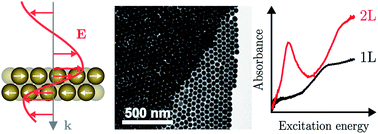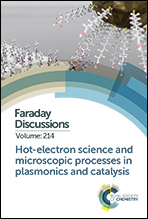Direct optical excitation of dark plasmons for hot electron generation
Abstract
An ideal plasmonic system for hot-electron generation allows the optical excitation of plasmons, limits radiation losses, exhibits strong non-radiative electron damping, and is made from scalable and cost-effective materials. Here we demonstrate the optical excitation of dark interlayer plasmons in bilayers of colloidal gold nanoparticles. This excitation is created by an antiparallel orientation of the dipole moments in the nanoparticle layers; it is expected to exhibit strongly reduced radiative damping. Despite the vanishing dipole moment, an incoming electromagnetic wave that is propagating normal to the surface will excite the dark mode due to field retardation. We observe a strong peak in the absorption spectrum of a colloidal gold bilayer (nanoparticle diameter = 46 nm); this peak is absent for a nanoparticle monolayer. The full width at half maximum of the dark mode is 230 meV for an ideal nanoparticle crystal and 320 meV for the structure produced by self-assembly out of solution. The position and width of the dark plasmon are efficiently tailored by the interparticle distance within the layer, nanoparticle size and layer number. We present time-resolved pump and probe experiments of hot-electron generation by bright and dark bilayer nanoparticle modes.

- This article is part of the themed collection: Hot-electron science and microscopic processes in plasmonics and catalysis


 Please wait while we load your content...
Please wait while we load your content...